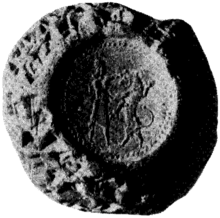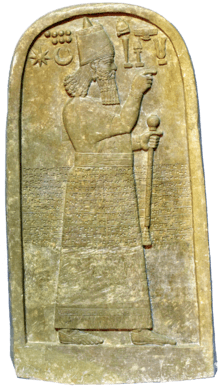Sin-shumu-lishir
Sin-shumu-lishir or Sin-shumu-lisher[3] (Akkadian: Sîn-šumu-līšir[4] or Sîn-šumu-lēšir[2]), also spelled Sin-shum-lishir,[5] was a usurper king in the Neo-Assyrian Empire, ruling some cities in northern Babylonia for three months in 626 BC during a revolt against the rule of the king Sinsharishkun. He was the only eunuch to ever claim the throne of Assyria.
| Sin-shumu-lishir | |
|---|---|
| King of Assyria | |
 | |
| Usurper in the Neo-Assyrian Empire | |
| Reign | 626 BC |
| Predecessor | Sinsharishkun |
| Successor | Sinsharishkun |
| Died | 626 BC |
| Akkadian | Sîn-šumu-līšir Sîn-šumu-lēšir |
| Religion | Ancient Mesopotamian religion |
Nothing is known of Sin-shumu-lishir's background or family and he first appears as a prominent courtier and general in the reign of Ashur-etil-ilani (r. 631–627 BC). After the death of Ashur-etil-ilani's father and predecessor Ashurbanipal (r. 669–631 BC), Sin-shumu-lishir was instrumental in securing Ashur-etil-ilani's rise to the throne and consolidating his position as king by defeating attempted revolts against his rule. It is possible that Sin-shumu-lishir, as a prominent general close to the king, was the de facto ruler of Assyria throughout Ashur-etil-ilani's reign.
Ashur-etil-ilani died in 627 BC after a very short reign and in the following year, Sin-shumu-lishir rebelled against Ashur-etil-ilani's brother and successor Sinsharishkun, possibly due to feeling that his prominent position was threatened by the rise of the new king. Sin-shumu-lishir successfully seized cities such as Nippur and Babylon but was defeated by Sinsharishkun after just three months.
Biography
Nothing is known of Sin-shumu-lishir's background or family.[6] He was a eunuch and probably already a prominent courtier during the reign of Ashurbanipal (r. 669–631 BC)[7] Eunuchs had often been appointed to prominent government positions in the Assyrian Empire because they could have no dynastic aspirations and thus in the mind of the Assyrians could not represent potential threats.[6] After Ashurbanipal's death, Sin-shumu-lishir played a key role in securing the rise of his son Ashur-etil-ilani to the throne, probably with the aid of his own private soldiers.[7] Sin-shumu-lishir is then first mentioned in Assyrian sources as the rab ša rēši (great/chief eunuch)[6] of Ashur-etil-ilani.[5] He is likely to have been the head of Ashur-etil-ilani's household[6] and was probably a prominent general who had served the new king since his youth.[5]
As in many other successions in Assyrian history, Ashur-etil-ilani's rise to the Assyrian throne in 631 BC was initially met with opposition and unrest.[8] An official named Nabu-rihtu-usur attempted to seize the Assyrian throne with the help of another official called Sin-shar-ibni. As the king's rab ša rēši, it is likely that Sin-shumu-lishir played a role in suppressing the conspiracy, which appears to have been crushed relatively quickly.[5] In addition to suppressing the revolt, there is also a preserved tablet which records a treaty imposed by Sin-shumu-lishir on three private individuals, guaranteeing Ashur-etil-ilani's sovereignty.[9] The text of this treaty is highly similar to the succession treaties created by Ashur-etil-ilani's grandfather Esarhaddon in the 670s BC to ensure the succession of Ashurbanipal.[10] Sin-shumu-lishir is also recorded as receiving land from Ashur-etil-ilani, possibly as a rewards for his service to the king.[5]
It is possible that Sin-shumu-lishir, as a prominent general closely tied to the king, was the de facto ruler of Assyria during Ashur-etil-ilani's reign. Ashur-etil-ilani died under obscure circumstances in 627 BC, after just four years as king. Ashur-etil-ilani's Babylonian vassal king Kandalanu also died at roughly the same time and Ashur-etil-ilani's brother Sinsharishkun assumed rulership of the entire Neo-Assyrian Empire. Immediately after Sinsharishkun became king, Sin-shumu-lishir rebelled against him, possibly due to feeling that his prominent position was threatened by the rise of a new king.[11] Though a military leader attempting to claim the throne during a time of crisis and succession wasn't necessarily unusual, the possibility that a eunuch would do so had never been entertained prior to Sin-shumu-lishir's attempt.[12] He was the only eunuch to ever claim the throne of Assyria.[6] It is possible that a set of undated seal impressions from Nineveh containing the image of a beardless king could depict Sin-shumu-lishir, as Assyrian kings were always depicted with beards but eunuchs were always depicted beardless.[2]
Seeking to seize power for himself, Sin-shumu-lishir quickly took some key cities in northern Babylonia, including Nippur and Babylon itself.[13] Though his area of control was limited to parts of Babylonia, Sin-shumu-lishir only claimed the title "King of Assyria", not "King of Babylon".[14] Sin-shumu-lishir never successfully took control of the Assyrian Empire and his tenure as "king" in Nippur and Babylon lasted only three months before Sinsharishkun successfully defeated him.[13]
Despite being a usurper and not successfully taking control of the Assyrian heartland, Sin-shumu-lishir is routinely listed in modern historiography as one of the final Assyrian kings, together with the legitimate rulers Ashur-etil-ilani and Sinsharishkun.[3][15]
References
- Herbordt 1992, p. 123.
- Watanabe 1999, p. 320.
- Perdue & Carter 2015, p. 40.
- Glassner 2004, p. 355.
- Ahmed 2018, p. 121.
- Oates 1992, p. 172.
- Leick 2002, p. 157.
- Na’aman 1991, p. 255.
- Grayson 1987, p. 130.
- Barré 1988, p. 83.
- Na’aman 1991, p. 256.
- Siddal 2007, p. 236.
- Lipschits 2005, p. 13.
- Beaulieu 1997, p. 386.
- Dalley 1994, p. 48.
Cited bibliography
- Ahmed, Sami Said (2018). Southern Mesopotamia in the time of Ashurbanipal. Walter de Gruyter GmbH & Co KG. ISBN 978-3111033587.
- Barré, Michael L. (1988). "A Note on the Sin-Shumu-Lishir Treaty". Journal of Cuneiform Studies. 40 (1): 81–83. doi:10.2307/1359710. JSTOR 1359710.
- Beaulieu, Paul-Alain (1997). "The Fourth Year of Hostilities in the Land". Baghdader Mitteilungen. 28: 367–394.
- Dalley, Stephanie (1994). "Nineveh, Babylon and the Hanging Gardens: Cuneiform and Classical Sources Reconciled". Iraq. 56: 45–58. doi:10.1017/S0021088900002801. JSTOR 4200384.
- Glassner, Jean-Jacques (2004). Mesopotamian Chronicles. SBL Press. ISBN 978-1589830905.
- Grayson, A. Kirk (1987). "Akkadian Treaties of the Seventh Century B.C.". Journal of Cuneiform Studies. 39 (2): 127–160. doi:10.2307/1359778. JSTOR 1359778.
- Herbordt, Suzanne (1992). Neuassyrische Glyptik des 8.-7. Jh. v. Chr. The Neo-Assyrian Text Corpus Project. ISBN 951-45-6047-7.
- Leick, Gwendolyn (2002). Who's Who in the Ancient Near East. Routledge. ISBN 978-0415132312.
- Lipschits, Oled (2005). The Fall and Rise of Jerusalem: Judah under Babylonian Rule. Eisenbrauns. ISBN 978-1575060958.
- Na’aman, Nadav (1991). "Chronology and History in the Late Assyrian Empire (631—619 B.C.)". Zeitschrift für Assyriologie. 81 (1–2): 243–267. doi:10.1515/zava.1991.81.1-2.243.
- Oates, Joan (1992). "The fall of Assyria (635–609 BC)". The Cambridge Ancient History Volume 3 Part 2: The Assyrian and Babylonian Empires and Other States of the Near East, from the Eighth to the Sixth Centuries BC. Cambridge University Press. ISBN 978-3111033587.
- Perdue, Leo G.; Carter, Warren (2015). Israel and Empire: A Postcolonial History of Israel and Early Judaism. Bloomsbury Publishing. ISBN 978-0567054098.
- Siddal, L. R. (2007). "A Re-Examination of the Title ša reši in the Neo-Assyrian period". In Azize, Joseph; Weeks, Noel (eds.). Gilgames̆ and the World of Assyria: Proceedings of the Conference Held at Mandelbaum House, the University of Sydney, 21-23 July, 2004. Peeters Publishers. ISBN 9789042918023.
- Watanabe, Kazuko (1999). "Seals of Neo-Assyrian Officials". In Watanabe, Kazuko (ed.). Priests and Officials in the Ancient Near East. Universitätsverlag C. Winter. ISBN 3-8253-0533-3.

